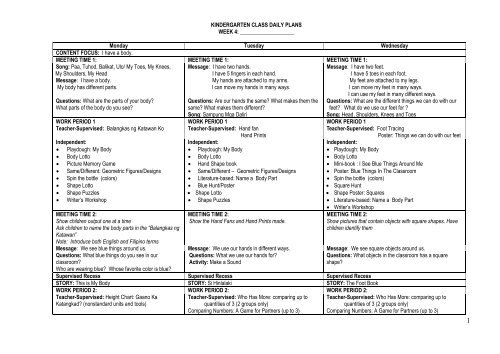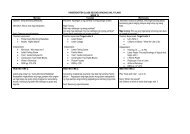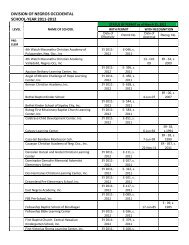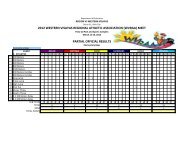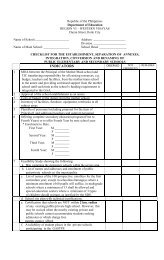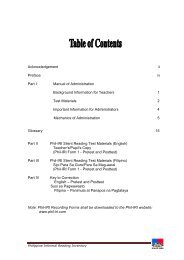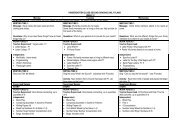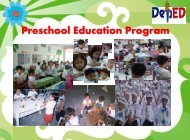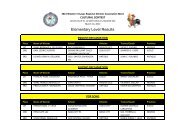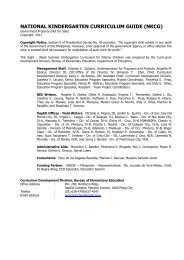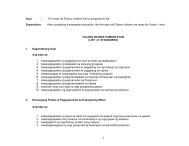5s 6s AM Class Fourth Quarter Daily Plans (sample)
5s 6s AM Class Fourth Quarter Daily Plans (sample)
5s 6s AM Class Fourth Quarter Daily Plans (sample)
Create successful ePaper yourself
Turn your PDF publications into a flip-book with our unique Google optimized e-Paper software.
KINDERGARTEN CLASS DAILY PLANS<br />
WEEK 4: ____________________<br />
Monday Tuesday Wednesday<br />
CONTENT FOCUS: I have a body.<br />
MEETING TIME 1: MEETING TIME 1: MEETING TIME 1:<br />
Song: Paa, Tuhod, Balikat, Ulo/ My Toes, My Knees,<br />
My Shoulders, My Head<br />
Message: I have a body.<br />
My body has different parts.<br />
Questions: What are the parts of your body?<br />
What parts of the body do you see?<br />
Message: I have two hands.<br />
I have 5 fingers in each hand.<br />
My hands are attached to my arms.<br />
I can move my hands in many ways.<br />
Questions: Are our hands the same? What makes them the<br />
same? What makes them different?<br />
Song: Sampung Mga Daliri<br />
Message: I have two feet.<br />
I have 5 toes in each foot.<br />
My feet are attached to my legs.<br />
I can move my feet in many ways.<br />
I can use my feet in many different ways.<br />
Questions: What are the different things we can do with our<br />
feet? What do we use our feet for ?<br />
Song: Head, Shoulders, Knees and Toes<br />
WORK PERIOD 1 WORK PERIOD 1 WORK PERIOD 1<br />
Teacher-Supervised: Balangkas ng Katawan Ko Teacher-Supervised: Hand fan<br />
Teacher-Supervised: Foot Tracing<br />
Hand Prints<br />
Poster: Things we can do with our feet<br />
Independent:<br />
Independent:<br />
Independent:<br />
� Playdough: My Body<br />
� Playdough: My Body<br />
� Playdough: My Body<br />
� Body Lotto<br />
� Body Lotto<br />
� Body Lotto<br />
� Picture Memory Game<br />
� Hand Shape book<br />
� Mini-book : I See Blue Things Around Me<br />
� Same/Different: Geometric Figures/Designs � Same/Different – Geometric Figures/Designs<br />
� Poster: Blue Things In The <strong>Class</strong>room<br />
� Spin the bottle (colors)<br />
� Literature-based: Name a Body Part<br />
� Spin the bottle (colors)<br />
� Shape Lotto<br />
� Blue Hunt/Poster<br />
� Square Hunt<br />
� Shape Puzzles<br />
� Shape Lotto<br />
� Shape Poster: Squares<br />
� Writer‟s Workshop<br />
� Shape Puzzles<br />
� Literature-based: Name a Body Part<br />
� Writer‟s Workshop<br />
MEETING TIME 2:<br />
MEETING TIME 2:<br />
MEETING TIME 2:<br />
Show children output one at a time<br />
Show the Hand Fans and Hand Prints made.<br />
Show pictures that contain objects with square shapes. Have<br />
Ask children to name the body parts in the “Balangkas ng<br />
Katawan”<br />
Note: Introduce both English and Filipino terms<br />
children identify them<br />
Message: We see blue things around us. Message: We use our hands in different ways. Message: We see square objects around us.<br />
Questions: What blue things do you see in our<br />
Questions: What we use our hands for?<br />
Questions: What objects in the classroom has a square<br />
classroom?<br />
Who are wearing blue? Whose favorite color is blue?<br />
Activity: Make a Sound<br />
shape?<br />
Supervised Recess Supervised Recess Supervised Recess<br />
STORY: This is My Body STORY: Si Hinlalaki STORY: The Foot Book<br />
WORK PERIOD 2: WORK PERIOD 2: WORK PERIOD 2:<br />
Teacher-Supervised: Height Chart: Gaano Ka<br />
Teacher-Supervised: Who Has More: comparing up to Teacher-Supervised: Who Has More: comparing up to<br />
Katangkad? (nonstandard units and tools)<br />
quantities of 3 (2 groups only)<br />
quantities of 3 (2 groups only)<br />
Comparing Numbers: A Game for Partners (up to 3)<br />
Comparing Numbers: A Game for Partners (up to 3)<br />
1
Independent::<br />
� Block Play<br />
� Playdough Numerals (1, 2, 3)<br />
� Number Stations (inch cubes or squares)<br />
� Number Books (squares)<br />
� Number Concentration (0-3)/ Number Lotto (0-3)<br />
� Fishing Game: Numbers (0-3)/ Bingo: Numbers (0-3)<br />
INDOOR/OUTDOOR ACTIVITY: Move that Body (PEHT<br />
p.55)<br />
Independent::<br />
� Block Play<br />
� Playdough Numerals (1, 2, 3)<br />
� Number Stations (inch cubes or squares)<br />
� Number Books (squares)<br />
� Number Snap (0-3)<br />
� Fishing Game: Numbers (0-3)/ Bingo: Numbers (0-3)<br />
Independent::<br />
� Block Play<br />
� Comparing Numbers: A Game for Partners (up to 3)<br />
� Playdough Numerals (1, 2, 3)<br />
� Writing Paper s (1)<br />
� Number Snap (0-3)<br />
� Number Concentration (0-3)/ Number Lotto (0-3)<br />
INDOOR/OUTDOOR ACTIVITY: Sabi ni Pedro - PEHT p.51 � INDOOR/OUTDOOR ACTIVITY: Movement Exploration<br />
PEHT p.219<br />
MEETING TIME 3: Dismissal Routine MEETING TIME 3: Dismissal Routine MEETING TIME 3: Dismissal Routine<br />
THURSDAY FRIDAY NOTES<br />
CONTENT FOCUS: I have a body.<br />
MEETING TIME 1: MEETING TIME 1:<br />
Song: Hokey Pokey/ Kanang Kamay<br />
Message: I have a face.<br />
My face has different parts.<br />
Questions: What are the parts of my face? Why do we<br />
need each part?<br />
Song: I Can Do Many Things PEHT p. 162<br />
Message: I can use my body in different ways.<br />
My body has different parts.<br />
(focus on the internal body parts)<br />
Questions: What are the other parts of our body?<br />
What parts of the body can we not see?<br />
Song: The Two Parts of Me<br />
WORK PERIOD 1 WORK PERIOD 1<br />
Teacher-Supervised: Silly Faces<br />
Teacher-Supervised: Body Tracing Poster: What‟s<br />
Literature-based: Character Mask inside our body? (Internal Body Parts)<br />
Independent:<br />
Independent:<br />
� Paper Plate Puppets<br />
� Silly Faces<br />
� Foot Tracing<br />
� Spot the Odd One Out ( shapes, designs)<br />
� Mini-book: Square Things Around Me<br />
� Hand Shape Book<br />
� Spot the Odd One Out ( shapes, designs)<br />
� Letter Lotto<br />
� Letter Lotto<br />
� Find a Match (letters)<br />
� Find a Match (Letters)<br />
� Group Book: Square Things Around Us<br />
� Writer‟s Workshop<br />
MEETING TIME 2: MEETING TIME 2:<br />
Show Silly Faces project/ output<br />
Questions: What activity do you enjoy doing most in<br />
Have children explore facial expressions using the different school?<br />
facial features<br />
What activity do you enjoy doing most at home?<br />
- mad<br />
What body parts help you do this?<br />
- scared<br />
Song: Everybody Do This (do hand and foot movements<br />
- surprised<br />
- happy<br />
and different facial expressions)<br />
2
- sad<br />
- sleepy<br />
- in deep thought<br />
Song: Igalaw mga Mata<br />
Supervised Recess Supervised Recess<br />
TULA: Ang Mukha Ni Bitoy STORY: Inside Me<br />
WORK PERIOD 2: WORK PERIOD 2:<br />
Teacher-Supervised: <strong>Class</strong>ification: Colors Teacher-Supervised: Color Pattern (using red-blue-yellow)<br />
Independent::<br />
Independent::<br />
� Block Play<br />
� Block Play<br />
� Comparing Numbers: A Game for Partners (up to 3) � <strong>Class</strong>ification: Colors<br />
� Playdough Numerals (1, 2, 3)<br />
� Comparing Numbers: A Game for Partners (up to 3)<br />
� Writing Paper s (1)<br />
� Playdough Numerals (1, 2, 3)<br />
� Number Snap (0-3)<br />
� Writing Paper s (1)<br />
� Number Concentration (0-3)/ Number Lotto (0-3) � Number Concentration (0-3)/ Number Lotto (0-3)<br />
� Fishing Game: Numbers (0-3)/ Bingo: Numbers (0-3)<br />
INDOOR/OUTDOOR ACTIVITY: Scrubbing the Floor PEHT<br />
p.217<br />
INDOOR/OUTDOOR ACTIVITY: Don‟t Touch PEHT p.53<br />
MEETING TIME 3: Dismissal Routine MEETING TIME 3: Dismissal Routine<br />
3
APPENDIX: WEEK 4<br />
A. THEME-RELATED ACTIVITIES<br />
Balangkas Ng Katawan Ko<br />
Objectives: Naipahahayag ang pagkamalikhain sa pagbakat sa papel ng bahagi ng katawan.<br />
Natutukoy ang iba‟t-ibang bahagi ng katawan<br />
Materials: papel na malapad, krayola o lapis, pandikit<br />
Number of Players/Participants: 8 children<br />
Procedure:<br />
1. Ilatag ang papel sa sahig.<br />
2. Pahigain ang bata sa papel.<br />
3. Pasundan sa kaklase ang balangkas ng katawan ng batag nakahiga.<br />
4. Pakulayan ang loob ng balangkas.<br />
5. Ipagupit at ipadikit sa isang papel na may patigas.<br />
6. Gawin ito sa lahat ng mga bata.<br />
7. Sulatan ng pangalan ang bawat balangkas.<br />
8. Paguhitan ang mata, ilong, at bibig ang mukha ng balangkas.<br />
9. Maaring lagyan ng may-ari ang kanyang balangkas ng baro, kamiseta, ribbon sa ulo, o anuman bagay na<br />
mapagkakakilanlan sa kanya.<br />
10. Ibitin sa dingding palibot sa silid aralan ang mga balangkas ng katawan.<br />
Hand Print<br />
Materials: paint, water, tissue paper, manila paper<br />
Number of Players/Participants: 8 children<br />
Procedure<br />
1. Dilute paint in water.<br />
2. Pour a small amount of this on paper plate.<br />
3. Put tissue paper on the paper plate. (This will prevent the paint from splashing once the children start dipping their<br />
hands into the paint.<br />
4. Have each child dip his hand into the paint then d let him stamp this on the manila paper.<br />
5. Ask the child to label her hand.<br />
6. Write the title “ This my handprint !! “<br />
Hand Fan<br />
Materials: pencil , crayons ,cardboard, popsicle stick<br />
Number of Players/Participants: 8 children<br />
Procedure:<br />
1. Help each child trace his/her hand on a cardboard.<br />
2. Cut the outline of the hand.<br />
3. Stick to this to a cardboard<br />
4. Have the child design his/her hand fan.<br />
Hand Shape Book – I Feel With My Hands<br />
Objective/Competency: To identify things we can touch<br />
Materials: 6-8 pages of ½ crosswise paper, pencils, crayons, stapler (Teacher writes the title on each of the booklets.)<br />
Number of Players/Participants: 8 children<br />
Procedure:<br />
� Teacher traces the handprint of each child and cuts out at least 6-8 pages of that handprint. She staples the pages<br />
together.<br />
� Let the children write their name on the cover page of the booklet.<br />
� Ask each child to think of things that he can touch.<br />
� For every page in the booklet, each child will draw an object that he can touch.<br />
� Take down dictation as each child describes his drawing.<br />
Foot Tracing<br />
Objective/Competency: tracing<br />
Materials. construction paper or bond paper, scissors, glue, manila paper<br />
4
Procedure:<br />
1. Give each a child a piece of paper.<br />
2. Have him trace his foot on it.<br />
3. Teacher cuts this out.<br />
4. Ask children to glue their hand cut-out on manila paper.<br />
Poster: Things we can do with our feet<br />
Objective: identify what one can do with one‟s feet<br />
Materials: Manila paper ¼ pieces of scratch bond paper pencil crayons<br />
Procedure:<br />
1. Discuss what the members of the group can do with their feet.<br />
2. Ask children to draw these on small pieces of paper.<br />
3. Glue the pieces of paper on the manila paper.<br />
Body Lotto<br />
Objective/Competency: body part recognition<br />
Materials: body part lotto cards, individual body parts cards<br />
Number of players/participant: 3-4 players or it can also be played by just one child<br />
Procedure:<br />
1. Distribute lotto cards and individual body part cards that correspond to the ones in the lotto card.<br />
2. Ask children to match body parts.<br />
3. Have them identify the body part as they match the cards.<br />
Silly Faces<br />
Objective/Competency: To identify the different parts of the face<br />
Materials: big cut-out circle from a white paper, old magazines, scissors, paste/glue<br />
Number of Players/Participants: 8 children<br />
Procedure:<br />
1. Look for the different facial features in the magazines and cut them out.<br />
2. Paste them on the white paper to form a face.<br />
Body Tracing Poster: What’s Inside Our Body?<br />
Objective/Competency: To identify the parts that is inside the body and their functions<br />
Materials: half-sized manila paper, marking pen, paste/glue, cut out pictures of brain, heart, lungs, stomach, bones and muscles<br />
and word cards of these body parts<br />
Number of Players/Participants: 8 children<br />
Procedure:<br />
1. Create a life size drawing of the body by tracing one of the members of the group.<br />
2. The rest of the members of the group will paste the picture of internal body parts on the right spot with the word/name<br />
cards.<br />
3. Let the children identify the function of each body part. (Example: heart - pumps blood through our body, lungs helps us<br />
to breathe, stomach turns food to energy, etc.)<br />
Playdough : My Body<br />
Objective/Competency: To identify the different body parts<br />
Materials: playdough<br />
Number of Players/Participants: 6 children<br />
Procedure:<br />
1. Give each child a medium-sized ball of playdough.<br />
2. Let the children form the whole body of a person.<br />
3. Ask them to identify the different body parts as they create.<br />
5
B. OTHER MATH ACTIVITIES<br />
Block Play<br />
Objective: to explore the attributes of 3-dimensional or space figures<br />
to understand the relationship between figures<br />
to build structures using blocks<br />
Materials: table or floor blocks<br />
No. of Participants: 1-4<br />
Procedure:<br />
Children use table or floor blocks to build structures.<br />
While building structures children are encouraged to talk about attributes of block (e.g. long/ short, heavy/light) and the<br />
relationship of each block to another (e.g. 2 of these blocks make 1 of these blocks)<br />
Same and Different (geometric figures/designs)<br />
Objective/ Competency: to identify similar objects<br />
Materials: picture cards, category cards<br />
Number of players/ participants: 2-4<br />
Preparation: Prepare several cards with similar geometric figures/ designs as well as different geometric figures/ designs<br />
Procedure:<br />
1. Have each child pick out 2 picture cards and tell whether the pictures are the same or different from one another/<br />
2. If they are the same, have him place this under the category card “ S<strong>AM</strong>E”. Let the child explain why the geometric<br />
figures/designs are the same.<br />
3. If the pictures are different from each other, have him place this under the category card “DIFFERENT”.<br />
4. Let the child explain why the geometric figures/designs are different from each other.<br />
Blue Hunt<br />
Objective/Competency: color recognition<br />
Materials: several blue objects, 1/8 manila paper, ¼ newsprint or bond paper, glue, crayons or markers<br />
Number of Players/Participants: 8 children<br />
Procedure:<br />
1. Tell children to look for blue objects in the classroom.<br />
2. Ask children to identify the objects that he/she found.<br />
3. Have them draw the blue objects that they find in small strips of paper.<br />
4. Paste this on 1/8 Manila paper.<br />
Poster: Blue Things in the <strong>Class</strong>room<br />
Objectives: color recognition<br />
Materials: ¼ manila paper, 1/6 newsprint or bond paper, glue, crayons or markers<br />
Number of Players/Participants: 8 children<br />
Procedure:<br />
1. Tell children to think of blue objects in their environment.<br />
2. Ask each one to choose at least 2-3 blue objects they would like to draw.<br />
3. Have them draw each blue object in a small strip of paper.<br />
4. Paste these on the pages on the manila paper.<br />
5. Show the poster to the whole class during Meeting Time.<br />
Mini-book : I See Blue Things Around Me<br />
Objectives: color recognition<br />
Materials: individual booklets, pencil, crayons or markers<br />
Number of Players/Participants: 8 children<br />
Procedure:<br />
1. Ask children to look for blue objects in the classroom.<br />
2. Have them draw each of these objects on the pages of the booklet.<br />
3. Let them label their drawings. Take down dictation as needed.<br />
6
Spin the Bottle (colors)<br />
Objectives: color recognition<br />
Number of Players/Participants: 8 children<br />
Materials: mineral water bottle, color cards , color graph<br />
Preparation: Make a graph like the one below:<br />
How many times did it land on …. ?<br />
RED<br />
BLUE<br />
YELLOW<br />
Procedure:<br />
1. Arrange the color cards around the circle.<br />
2. At each turn, a child spins the bottle.<br />
3. Have the child identify the color of the card to which the top part of the bottle is pointing to.<br />
4. Let them record how many times the spinner landed on a particular color by drawing sticks on each<br />
column.<br />
<strong>Class</strong>ification: Color<br />
Objective: to classify objects according to color<br />
Materials: objects of different colors: red, blue and yellow<br />
3 boxes, 1 labeled RED, 1 labeled BLUE, 1 labeled YELLOW<br />
No. of Participants: 1-4<br />
Procedure:<br />
1. Children are given a junk box filled with objects that come in 3 colors: red, blue and yellow.<br />
2. Children determine which box to place each object in depending on its color<br />
Color Pattern: Red-Blue-Yellow<br />
Objective: to extend and reproduce a pattern<br />
Materials: block or cards of 3 different colors: red, blue and yellow<br />
No. of Participants: 2-4<br />
Procedure:<br />
1. Children take turns using the blocks or card to make color patterns.<br />
2. Other children in the group reproduce or extend the pattern made<br />
Shape Lotto<br />
Objective: to match shapes of the same color<br />
Materials: playing board with drawings of different shapes, calling cards with shapes that match<br />
playing board<br />
Procedure:<br />
1. Make some boards with shapes drawn on them and cut some shapes out card to match.<br />
2. Teacher holds up each shape in turn for the players to claim.<br />
3. Continue until someone fills up his or her board.<br />
Square Hunt<br />
Objectives: to recognize square objects in the environment<br />
Materials: several square objects, 1/8 manila paper, ¼ newsprint or bond paper, glue, crayons or markers<br />
Number of Players/Participants: 8 children<br />
Procedure:<br />
1. Tell children to look for square objects in the classroom.<br />
2. Ask children to identify the objects that they found.<br />
3. Have them draw the square objects in small strips of paper.<br />
4. Paste these on 1/8 Manila paper.<br />
5. Write the title “ There are square objects around us. “<br />
Shape Poster: Squares<br />
Objective: to recognize shapes<br />
Materials: ¼ manila paper , strips of paper ( 1/8 of bond paper)<br />
7
Number of players/participant: 6-8 participants<br />
Procedure:<br />
1. Draw the shape on top of the page. Then write the title, “I see square objects around me .“<br />
2. Ask each child to draw square objects that they see around them. Start with the ones in the classroom.<br />
3. Children name the objects in the poster.<br />
4. Children stick their drawings into the Manila paper.<br />
5. Teacher presents their poster to the whole class during Meeting time 2.<br />
Big Book: Square Things Around Us<br />
Objectives: shape recognition<br />
Materials: stapled pages of manila paper cut out into squares, crayons, pencil , markers<br />
Number of Players/Participants: 8 children<br />
Procedure:<br />
1. Ask children to think of square objects in their environment.<br />
2. Ask each one to choose at least 3-4 square objects they would like to draw.<br />
3. Have them draw each square object on a small strip of paper.<br />
4. Paste these on the pages of the Big Book.<br />
5. Have children design the cover of the book.<br />
6. Show to the whole class during Meeting Time.<br />
Shape Puzzles<br />
Objective/Competency: fine motor coordination; shape recognition<br />
Materials: 6-8 sets of shape puzzles<br />
Preparation: Make shape boards cut out in 3-4 puzzle pieces.<br />
Number of Players/Participants: 2-4 children<br />
Procedure:<br />
1. Distribute one set of shape puzzle to each child.<br />
2. Have him assemble the pieces to form a shape.<br />
3. Ask him to draw each shape he has formed on his paper.<br />
Spot the Odd Out (geometric figures and designs)<br />
Objective/Competency: To identify the picture that does not belong in a given series<br />
Materials: picture cards shapes and designs, counters<br />
Participants: 8 children<br />
Procedure:<br />
1. Distribute” a spot the odd one out card “to each child.<br />
2. Let him identify the picture in the cards.<br />
3. Ask each child to put a counter over the picture that is different from the rest.<br />
Who Has More?<br />
Objective: to compare quantities up to 3<br />
Materials: assorted materials such as toothpicks, buttons, marbles<br />
No. of Participants: 1 or more<br />
Procedure:<br />
1. Put out about three saucers, each with a different number of things in, for example, three peas, two pebbles, one<br />
marble.<br />
2. The child points at two saucers and chooses without counting out, which has more.<br />
3. Child then checks by pairing up the contents of the two saucers.<br />
Variations:<br />
1. Put the same number of things in two of the saucers.<br />
2. Put three big things and three small things in another saucer.<br />
3. Put out bigger number of things.<br />
Comparing Numbers – A Game For Partners<br />
Objective: Compares quantities<br />
Number of Players/ Participants: 3 pairs<br />
Materials: clothespins, small card numbers, More/less spinner<br />
1. Each player draws a numeral card from a pile of cards.<br />
2. They each build the appropriate clothespin stack to match their cards.<br />
8
3. One child turns the more/less spinner. If it lands on less, the partner whose stack has lesser clothespins wins both<br />
stacks. If the spinner lands on more, the partner with more clothespins wins both stacks.<br />
4. They continue to take turns, each accumulating clothespins.<br />
5. When the time is up or the children decide to end the game, they snap together all the clothespins. They turn the<br />
spinner to see if the person who has accumulated more or less clothespins is the winner.<br />
Playdough Numerals (1-3)<br />
Objective/Competency: To identify the numerals 1, 2 and 3<br />
Materials: playdough<br />
Number of Players/Participants: 6 children<br />
Procedure:<br />
1. Give each child a medium-sized ball of playdough.<br />
2. Let them to form the numerals 1, 2 and 3.<br />
3. Then ask each child to create the number of objects for each numeral. (Example: 2 hearts – numeral 2)<br />
Writing Papers (1)<br />
Objective: to learn sequence<br />
To observe the form of each numeral<br />
To develop eye-hand coordination<br />
Materials: writing papers (with number dot patterns for each numeral)<br />
crayon<br />
Number of participants: individual<br />
Procedure:<br />
� Each child is given a writing paper with the numeral he is working on, in this case 1.<br />
� Children use a crayon to connect the dots of the number pattern.<br />
Number Stations (quantities of 3)<br />
Objective/Competency: To count up to quantities of 3<br />
To see that despite differences in appearance quantities remain the same (conservation)<br />
To develop fine motor coordination<br />
Materials: 1”x1” pieces of squares or inch cubes<br />
Number of Players/Participants: 8 children<br />
Procedure:<br />
1. Teacher chooses a number to work with for the day, in this case 3.<br />
2. Children work together exploring a given quantity of toothpicks, in this case 3, making as many arrangements as<br />
possible. Then let the children write the number on their paper.<br />
3. Teacher encourages the children to describe the toothpick patterns in a variety of ways.<br />
(Variation: children can explore other materials such as pebbles, popsicle sticks, blocks and others.)<br />
Number Books (quantities of 3)<br />
Objective/Competency: To use numerals to describe and record quantities<br />
Materials: 1”x1” pieces of squares<br />
Procedure:<br />
Glue the designs from the Number Stations activity on sheets of paper. Bind the paper to make a book<br />
Variation: Help your child to draw pictures or glue in pictures from magazines of things that are important to him and<br />
write a number caption underneath (e.g. 3 pairs of shoes, 3 bottles of juice)<br />
Number Lotto<br />
Objective: to match numerals<br />
Number of Players/ Participants: 2-4<br />
Materials: lotto boards, 2 sets of number cards, 0-3<br />
Procedure:<br />
1. Give each player a lotto board.<br />
2. Players take turns to pick up a card from the deck.<br />
3. If the number appears on their board they use this to cover the number up.<br />
4. Continue until someone fills their board.<br />
9
Variation: One person is a caller as in a bingo game. She holds u the number cards and players have to shout out the name of<br />
the number in order to claim it to put on their board.<br />
Number Concentration<br />
Objective: to match numerals<br />
Number of Players/ Participants: 2-4<br />
Materials: 2 sets of number cards, 0-3<br />
Procedure:<br />
1. Lay the cards down, either in rows or just anyhow.<br />
2. Take turns turning over 2 cards.<br />
3. If the cards match, you win them. If not, turn them face down again.<br />
4. Player with most number of cards win.<br />
Fishing Game: Numbers<br />
Objective: to recognize and identify numerals<br />
Number of Players/ Participants: 2-4<br />
Materials: fish cut-outs (that have the numbers 0-3 written on them) with paper clip, fishing rod with magnet<br />
Procedure:<br />
1. Set up a “fishing area” where fish with shapes are placed on the floor.<br />
2. Children take turns using the fishing rod to catch a „fish‟.<br />
3. When a child catches a „fish‟ he identifies the number written on the fish.<br />
4. The next child takes his turn.<br />
Bingo: Numbers (0-3)<br />
Objective: to match numerals<br />
Number of Players/ Participants: 2-4<br />
Materials : bingo card for each player calling cards tokens<br />
Procedure:<br />
1. Provide each player with a bingo card.<br />
2. Assign a student to call out what is written on calling cards.<br />
3. First one to cover all spaces wins. If players go through all the cards without reaching Bingo, they should reshuffle the<br />
cards, then turn them face down again and continue playing until someone has won.<br />
Number Snap<br />
Objective: to match numerals<br />
Number of Players/ Participants: 2-4<br />
Materials: 3 sets of number cards, 0-3<br />
Procedure:<br />
1. Shuffle and deal the cards.<br />
2. The players take it in turns to turn over their top card.<br />
3. If two matching cards are turned over, the first player to shout "snap" wins both the piles concerned.<br />
4. Continue until only one player is left.<br />
Variation: Make a set of cards with the numbers shown in different ways.<br />
Height Chart: Gaano Ka Katangkad<br />
Objective: to measure height using nonstandard units and tools<br />
Number of players/ participants: 6-8 at a time<br />
Materials: strips of old newspaper about 1 inch thick glue Manila paper<br />
Procedure:<br />
1. Ask the children to form a line from shortest to tallest. Encourage them to compare heights among themselves<br />
2. Children get strips of newspaper and glue about 2 or more strips together.<br />
3. By pairs, children measure each other‟s height using the newspaper strips.<br />
4. Glue the newspaper strips on the sheet of Manila paper from shortest to longest. Label the strip with each child‟s name.<br />
5. Now compare the result of the Height Chart with the results of the discussion earlier when the children formed a line.<br />
10
C. OTHER LANGUAGE ARTS ACTIVITIES<br />
Writer’s Workshop<br />
Objective/Competency: to develop expressing language skills<br />
Materials: individual booklets, pencil, crayons or markers<br />
Number of Players/Participants: any number<br />
Procedure:<br />
1. Distribute individual booklets or loose pages to each child.<br />
2. Have him draw on the pages of this booklet.<br />
3. Let him color his work.<br />
4. Ask him to write/dictate to you the title of his story.<br />
Note: In the initial stages of writer‟s workshop, the child must be allowed to draw whatever he wants on the pages of this booklet.<br />
Have him tell you what he drew and take down dictation as needed OR if the child can already write letters, encourage him to<br />
write key words to describe what he drew.<br />
As the child gains more confidence in writing, he can be encouraged to write his own stories. It could be about a personal<br />
experience or something he read about or an original one. Have him think about what happens in the beginning, middle and end<br />
of his story.<br />
Writer‟s Workshop must be done at least 3x a week.<br />
Lit-based Activity: Name the Body Part<br />
Objective/Competency: To make personal connections<br />
Materials: ½ sheet crosswise white paper, pencils, crayons<br />
Number of Players/Participants: 10 children<br />
Procedure:<br />
1. Ask the children to give one body part mentioned in the story and tell us what that body part can do.<br />
2. Give each child a piece of paper and ask him to draw his answer<br />
3. Take down dictation as needed.<br />
4. Compile the stories and make it into a book. Write the title of the book.<br />
Lit-based Activity: Character Mask<br />
Objective/Competency: To identify the different facial features<br />
Materials: paper plate, cut-out shapes from colored papers, scissors, paste/glue<br />
Number of Players/Participants: 8 children<br />
Procedure:<br />
1. Ask children to recall the characters in the story and choose one they will make a mask for.<br />
2. Give each child a paper plate and help him lay-out the shapes on the paper plate to form a face.<br />
3. Ask each child to identify the different facial features.<br />
4. Have them show the masks to the rest of the class during Meeting Time 2.<br />
Letter Lotto<br />
Objective/Competency: letter recognition<br />
Materials: lotto cards<br />
Number of players/participant: 3-4 players or it can also be played by just one child<br />
Procedure:<br />
1. Distribute lotto cards and individual letter cards that correspond with the letters on the lotto cards.<br />
2. Students match individual letter cards with the letters on the lotto board.<br />
3. Students exchange cards after. Give each child a chance with all the lotto cards.<br />
Variation : You can do this for lower case letters as well. At a later stage of the school year, you may also provide upper/lower<br />
case lotto where children will match upper and lower case letters instead of just matching identical letters.<br />
Find a Match (letters)<br />
Objective/Competency: matching letters<br />
Materials: 15 pairs of identical letters<br />
Number of players/participant: 3-4 players or it can also be played by just one child<br />
Procedure:<br />
1. Spread individual letter cards upside down on the table (or floor) .<br />
11
2. Each one in the group takes turns looking for pairs of identical letters.<br />
3. As each one picks a pair, the group sounds out the letter, give its letter name and thinks of one word that begins with<br />
this particular letter.<br />
Make the Sounds<br />
Objective: reproduce sequences of sounds<br />
Materials : none<br />
Procedure:<br />
1. Have children identify single sounds first.<br />
2. Then let them identify each one in a given sequence of sounds.<br />
3. Have children cover their eyes with their hands while you make a familiar noise such as closing the door, sneezing, or<br />
playing a key on the piano. By listening carefully and without peeking, the children are to try to identify the noise.<br />
4. Once children have caught on the game, make two more noises, one after the other.<br />
5. Without looking, have children guess the two sounds in sequence saying, ““There were two sounds. First we<br />
heard a ____, and then we heard a ____.”<br />
Variation: After they have mastered this, produce series of more than two for them to identify and report in sequence. Again,<br />
complete sentences should be encouraged.<br />
D. SONGS/POEMS/ RHYMES<br />
My Toes, My Knees, My Shouders, My Head<br />
My toes, my knees, my shoulders, my head (3x)<br />
Let‟s clap our hands together.<br />
Head, Shoulders, Knees And Toes<br />
Head, shoulders, knees and toes<br />
Knees and toes<br />
Head, shoulders, knees and toes<br />
Knees and toes<br />
Eyes and ears and mouth and nose<br />
Head, shoulders, knees and toes<br />
Knees and toes<br />
Igalaw Mga Mata<br />
Sung to the tune of Twinkle Little Star<br />
Halina ating igalaw,<br />
Dalawang matang malilinaw.<br />
Idilat at ipikit<br />
At sundan nang Repeat<br />
Pakurap-kurap.<br />
Hokey, Pokey<br />
Put your right hand in<br />
Put your right hand out<br />
Put your right hand in<br />
And shake it all about<br />
And do the hokey, pokey<br />
And you turn yourself around<br />
That‟s what it‟s all about.<br />
Change right hand with: left hand, right foot, left foot, head,<br />
body<br />
Paa, Tuhod, Balikat, Ulo<br />
Paa, tuhod, balikat, ulo (3x)<br />
Magpalakpakan tayo.<br />
Sampung Mga Daliri<br />
Sampung mga daliri<br />
Kamay at paa<br />
Dalawang tainga<br />
Dalawang mata<br />
Ilong na maganda<br />
The Two Parts Of Me<br />
I have two hands to clap (clap) when I am happy,<br />
I have two lungs to breath (take a deep breath) for me to live,<br />
I have two eyes to see (point to eyes)the beauty that surrounds<br />
me,<br />
I have two legs to run and jump (jog in place) with playmates,<br />
I have two ears to hear (cup hands to ears) what teacher will<br />
tell me<br />
Kanang Kamay<br />
Kanang kamay<br />
Sa harap ilagay<br />
Kanang kamay sa likod<br />
Kanang kamay<br />
Sa harap ilagay<br />
Kumendeng-kendeng at umikot-ikot<br />
Baguhin ang kanang kamay nang: kaliwang kamay, kanang<br />
paa, kaliwang paa, ulo, buong katawan<br />
12
Everybody Do This…Just Like This<br />
Everybody do this, do this, do this (2x)<br />
Just like this.<br />
Teacher makes a body movement, example, clapping<br />
hands, and the children imitate her while they are singing.<br />
I Can Do Many Things PEHT – p.162<br />
Sung to the tune of Bahay Kubo<br />
BATANG MUNTI<br />
Ako‟y batang munti<br />
Na may laging mithi<br />
Maganda ang ugali<br />
Mabuti ang gawi<br />
Kahit batang munti<br />
E. INDOOR/OUTDOOR G<strong>AM</strong>ES<br />
BISIG<br />
Itong ating bisig<br />
Matatag, makisig<br />
Kung magkakabigkis<br />
Lahat makakamit<br />
Dito sa daigdig<br />
BALIKAT<br />
Sukatan ng lakas<br />
Ang ating balikat<br />
Kung may binubuhat<br />
Bagay na mabigat<br />
Dito sumasadlak<br />
BUHOK<br />
Itong ating buhok<br />
Tuwid man o kulot<br />
Sa ulo ay suklob<br />
Pampagandang lubos<br />
Kaloob ng Diyos<br />
Move That Body<br />
Objective/Competency: To demonstrate movement of different body parts<br />
Materials: CD player, CD (music)<br />
Procedure:<br />
� Children and teacher do deep breathing and other simple stretching exercises to loosen tight muscles, concentrating on<br />
certain body parts. Example: hand, feet, head<br />
� The teacher starts the music and tells the children: “Move your hand…feet…etc” in any way you want.<br />
� Children move their body parts with music.<br />
� End the activity with deep-breathing exercise.<br />
(Note: Direction of the movement varies – example: up and down, back and forth, etc. The quality of movement can also be<br />
varied – example: slow and fast, quiet and loud, light and heavy, happy and sad. Different kinds of music can be used in<br />
various movements.)<br />
Sabi ni Pedro<br />
Objective/Competency: To learn to hear discriminately and able to follow instruction.<br />
Materials: wala<br />
Number of Players/Participants: buong klase<br />
Procedure:<br />
� Hatiin ang klase sa dalawang pangkat. Iayos nang pabilog ang bawat pangkat.<br />
� Pansamantalang magtalaga ng “Pedro” sa bawat pangkat at patayuin siya sa gitna ng bilog.<br />
� Magbibigay siya ng mga utos tulad ng “Hawakan ang ilong,” “Hawakan ang mata,” at iba pa.<br />
� Ang utos ay maaring pangunahan o hindi ng mga salitang “Sabi ni Pedro.” Hindi dapat sundin si “Pedro” kapag ang utos<br />
ay walang pang-unang salitang “Sabi ni Pedro”. Halimbawa: “Hawakan ang leeg.” (Hindi dapat sundin.) “Sabi ni Pedro,<br />
hawakan ang leeg.” (Sundin ito.)<br />
� Maaring ibang bahagi ng katawan ang hawakan ni Pedro kaysa sa kanyang sinasabi upang lituhin ang mga bata.<br />
� Ang batang magkamali ang magiging bagong “Pedro.”<br />
Movement Exploration (PEHT p. 219)<br />
Scrubbing the Floor (PEHT p. 219)<br />
Don’t Touch (PEHT p. 53)<br />
13


